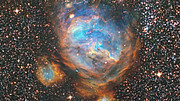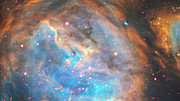PR Image eso1903a
Bubbles of Brand New Stars
Jumbo Jets
Digitized Sky Survey image around the HII region LHA 120-N 180B
The HII region LHA 120-N 180B in the constellation Mensa
Jet Infographic
Videos
Zooming in on the HII Region LHA 120-N 180B
Panning across N180
This dazzling region of newly-forming
stars in the Large Magellanic Cloud (LMC) was captured by the Multi Unit
Spectroscopic Explorer instrument (MUSE) on ESO’s Very Large Telescope.
The relatively small amount of dust in the LMC and MUSE’s acute vision
allowed intricate details of the region to be picked out in visible
light.
This region of the Large Magellanic Cloud (LMC) glows in striking colours in this image captured by the Multi Unit Spectroscopic Explorer (MUSE) instrument on ESO’s Very Large Telescope (VLT). The region, known as LHA 120-N 180B — N180 B for short — is a type of nebula known as an H II region (pronounced “H two”), and is a fertile source of new stars.
The LMC is a satellite galaxy
of the Milky Way, visible mainly from the Southern Hemisphere. At only
around 160 000 light-years away from the Earth, it is practically on our
doorstep. As well as being close to home, the LMC’s single spiral arm appears nearly face-on, allowing us to inspect regions such as N180 B with ease.
H II regions are interstellar clouds of ionised hydrogen —
the bare nuclei of hydrogen atoms. These regions are stellar nurseries —
and the newly formed massive stars are responsible for the ionisation
of the surrounding gas, which makes for a spectacular sight. N180 B’s
distinctive shape is made up of a gargantuan bubble of ionised hydrogen
surrounded by four smaller bubbles.
Deep within this glowing cloud, MUSE has spotted a jet emitted by a fledgling star — a massive young stellar object
with a mass 12 times greater than our Sun. The jet — named Herbig–Haro
1177, or HH 1177 for short — is shown in detail in this accompanying
image. This is the first time such a jet has been observed in visible
light outside the Milky Way, as they are usually obscured by their dusty
surroundings. However, the relatively dust-free environment of the LMC
allows HH 1177 to be observed at visible wavelengths. At nearly 33
light-years in length, it is one of the longest such jets ever observed.
HH 1177 tells us about the early lives of stars. The beam is highly collimated; it barely spreads out as it travels. Jets like this are associated with the accretion discs
of their star, and can shed light on how fledgling stars gather matter.
Astronomers have found that both high- and low-mass stars launch
collimated jets like HH 1177 via similar mechanisms — hinting that
massive stars can form in the same way as their low-mass counterparts.
MUSE has recently been vastly improved by the addition of the Adaptive Optics Facility , the Wide Field Mode of which saw first light in 2017.
Adaptive optics is the process by which ESO’s telescopes compensate for
the blurring effects of the atmosphere — turning twinkling stars into
sharp, high-resolution images. Since obtaining these data, the addition
of the Narrow Field Mode, has given MUSE vision nearly as sharp as that of the NASA/ESA Hubble Space Telescope — giving it the potential to explore the Universe in greater detail than ever before.
More Information
This research was presented in a paper entitled “An optical
parsec-scale jet from a massive young star in the Large Magellanic
Cloud” which appeared in the journal Nature.
The research team was composed of A. F. McLeod (who
conducted this research while at the University of Canterbury, New
Zealand and is now affiliated with the Department of Astronomy,
University of California, Berkeley, and the Department of Physics and
Astronomy, Texas Tech University, USA), M. Reiter (Department of
Astronomy, University of Michigan, Ann Arbor, USA), R. Kuiper (Institute
of Astronomy and Astrophysics, University of Tübingen, Germany), P. D.
Klaassen (UK Astronomy Technology Centre, Royal Observatory Edinburgh,
UK) and C. J, Evans (UK Astronomy Technology Centre, Royal Observatory
Edinburgh, UK).
ESO is the foremost intergovernmental astronomy
organisation in Europe and the world’s most productive ground-based
astronomical observatory by far. It has 16 Member States: Austria,
Belgium, the Czech Republic, Denmark, France, Finland, Germany, Ireland,
Italy, the Netherlands, Poland, Portugal, Spain, Sweden, Switzerland
and the United Kingdom, along with the host state of Chile and with
Australia as a Strategic Partner. ESO carries out an ambitious programme
focused on the design, construction and operation of powerful
ground-based observing facilities enabling astronomers to make important
scientific discoveries. ESO also plays a leading role in promoting and
organising cooperation in astronomical research. ESO operates three
unique world-class observing sites in Chile: La Silla, Paranal and
Chajnantor. At Paranal, ESO operates the Very Large Telescope and its
world-leading Very Large Telescope Interferometer as well as two survey
telescopes, VISTA working in the infrared and the visible-light VLT
Survey Telescope. ESO is also a major partner in two facilities on
Chajnantor, APEX and ALMA, the largest astronomical project in
existence. And on Cerro Armazones, close to Paranal, ESO is building the
39-metre Extremely Large Telescope, the ELT, which will become “the
world’s biggest eye on the sky”
Links
Contacts
Anna McLeod
Postdoctoral Research Fellow — Texas Tech University & University of California Berkeley
Tel: +1 80 6834 2588
Email: anna.mcleod@ttu.edu
Calum Turner
ESO Public Information Officer
Garching bei München, Germany
Tel: +49 89 3200 6670
Email: pio@eso.org







